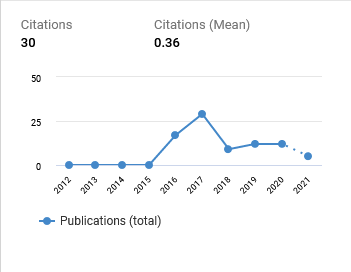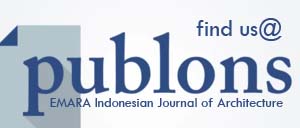Analysis of sense of places effect on tourist’s length of stay in the Khota Baru cultural heritage zone
DOI:
https://doi.org/10.29080/eija.v6i1.902Keywords:
the sense of place, heritage site, tourist length of stayAbstract
Heritage and cultural tourism are part of the tourism industry that must be maintained sustainability. Therefore heritage tourism destinations must be able to carry a “sense of place” as its focus. A sense of place is essential in attracting tourists to visit heritage sites for a long time. This article aims to assess the relationship between the Sense of Place between tourists, domestic and international, and the length of stay in the Kota Bharu Cultural Heritage Zone. A total of 445 tourists participated as respondents by filling out a questionnaire survey. At the same time, data analysis was carried out using One way ANOVA. The results showed that the Sense of Place in the Kota Bharu Cultural Heritage Area affects tourists' length of stay with eight correlated scales. Those eight scales are authenticity, historical value, distinction, harmony, maintainability, and cleanliness. This study also finds several important implications for local governments and tourism practitioners in maintaining a tourism destination's economic and social attributes. This study is expected to serve as the basis for future studies related to the design of urban areas and other heritage tourism sites
Downloads
References
Ahmed, S. (2009). Methods in Sample Survey: Simple Random Sampling Systematic Sampling [Class material]. http://ocw.jhsph.edu/courses/StatMethodsForSampleSurveys/PDFs/
Alén, E., Nicolau, J. L., Losada, N., & Domínguez, T. (2014). Determinant factors of senior tourists’ length of stay. Annals of Tourism Research, 49, 19–32. https://doi.org/10.1016/j.annals.2014.08.002
Alvi, M. (2016). A Manual for Selecting Sampling Techniques in Research. Munich University Library. https://mpra.ub.uni-muenchen.de/70218/
Barros, C. P., & Machado, L. P. (2010). The length of stay in tourism. Annals of Tourism Research, 37(3), 692–706. https://doi.org/10.1016/j.annals.2009.12.005
Botes, V. L. (2009). The perception of the skills required and displayed by management accountants to meet future challenges [Thesis, University of South Africa]. http://uir.unisa.ac.za/handle/10500/1935
Bott, S. E. (2000). The development of psychometric scales to measure sense of place. Colorado State University.
Counted, V. (2019). The Role of Spirituality in Promoting Sense of Place Among Foreigners of African Background in the Netherlands. Ecopsychology, 11(2), 101–109. https://doi.org/10.1089/eco.2018.0070
de Menezes, A. G., Moniz, A., & Vieira, J. C. (2008). The determinants of length of stay of tourists in the Azores. Tourism Economics. https://doi.org/10.5367/000000008783554866
Frerichs, R. R. (2008). Simple Random Sampling [Course material]. Rapid Survey Course. http://www.ph.ucla.edu/epi/rapidsurveys/RScourse/RSrapidsurveys.html
Hauge, Å. L. (2007). Identity and Place: A Critical Comparison of Three Identity Theories. Architectural Science Review, 50(1), 44–51. https://doi.org/10.3763/asre.2007.5007
Idrus, A., Khamidi, F., & Sodangi, M. (2010). Maintenance Management Framework for Conservation of Heritage Buildings in Malaysia. Modern Applied Science, 4(11), p66. https://doi.org/10.5539/mas.v4n11p66
Kazuzuru, B. (2014). Determinants of tourist length of stay in Tanzania. International Journal of Business and Social Science, 5(9), 11. http://ijbssnet.com/journals/Vol_5_No_9_1_August_2014/
Kelantan Tourism Information Centre. (2017). Kelantan Tourist Arrival Statistic.
McCunn, L. J., & Gifford, R. (2014). Interrelations between sense of place, organizational commitment, and green neighborhoods. Cities, 41, 20–29. https://doi.org/10.1016/j.cities.2014.04.008
Mora, R.-J., & Kloet, B. (2010). Digital Forensic Sampling. SANS Digital Forensics and Incident Response Blog. https://www.sans.org/blog/digital-forensic-sampling/
Pretty, G. H., Chipuer, H. M., & Bramston, P. (2003). Sense of place amongst adolescents and adults in two rural Australian towns: The discriminating features of place attachment, sense of community and place dependence in relation to place identity. Journal of Environmental Psychology, 23(3), 273–287. https://doi.org/10.1016/S0272-4944(02)00079-8
Raadik-Cottrell, J. (2010). Cultural memory and place identity: Creating place experience [Dissertation]. Colorado State University.
Santos, G. E. de O., Ramos, V., & Rey-Maquieira, J. (2014). Length of stay at multiple destinations of tourism trips in brazil: Journal of Travel Research, 54(6), 788–800. https://doi.org/10.1177/0047287514532370
Shalab. (2019). Introduction to Sampling Theory. Indian Institute of Technology Kanpur. http://home.iitk.ac.in/~shalab/course432.htm
Smaldone, D. (2007). The role of time in place attachment. Proceedings of the 2006 Northeastern Recreation Research Symposium, 14, 57–56. https://www.fs.usda.gov/treesearch/pubs/12653
Tan, S.-K., Tan, S.-H., Kok, Y.-S., & Choon, S.-W. (2018). Sense of place and sustainability of intangible cultural heritage – The case of George Town and Melaka. Tourism Management, 67, 376–387. https://doi.org/10.1016/j.tourman.2018.02.012
Thrane, C., & Farstad, E. (2012). Tourists’ Length of Stay: The Case of International Summer Visitors to Norway: Tourism Economics, 18(5), 1069–1082. https://doi.org/10.5367/te.2012.0158

Downloads
Published
How to Cite
Issue
Section
Categories
License
- Authors retain copyright and grant the journal right of first publication with the work simultaneously licensed under a Creative Commons Attribution ShareAlike License that allows others to share the work with an acknowledgment of the work's authorship and initial publication in this journal.
- Authors are able to enter into separate, additional contractual arrangements for the non-exclusive distribution of the journal's published version of the work (e.g., post it to an institutional repository or publish it in a book), with an acknowledgment of its initial publication in this journal.
- Authors are permitted and encouraged to post their work online (e.g., in institutional repositories, pre-print sites, or on their website) prior to and during the submission process, as it can lead to productive exchanges, as well as earlier and greater dissemination of published work.
































